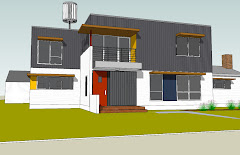As we have been designing this house addition and remodeling, it has been tempting to say "let's just demolish the whole thing and start over". We may even find that in the end, certain items are easier to just tear out and rebuild, rather than fixing and patching what is already there. As we are working with existing conditions, there are definitely some compromises that we are having to make.
So why does it make sense to remodel and salvage as much as possible? The simple answer is money. We have a modest project budget. The more complex answer has to do with embodied energy. Embodied energy refers to the total quantity of energy required to construct a building or create a product. It goes way back to the extraction of materials from the earth, the energy required to create the product from the materials, the transportation of the materials/product, the installation of the product, etc. The more durable a product and/or material is and the longer it remains in service, the lower it's embodied energy quotient will be. This is a good thing.
The more we reuse of the existing house, the more money we will likely save and the lower our embodied energy and carbon footprint (more about this in a later post) will be.
Although there are some fun and funky equations that can be used to measure embodied energy, the analysis we are doing is much more subjective. For example, as we are planning on removing all the existing siding, adding insulation and residing with new materials, we were also planning on new windows to replace the existing. As designers, we want the entire house to have a consistent look and with new windows, we can better predict the energy performance. But after the initial estimates came in, we were forced to look harder at the decision to replace all the existing windows. The existing windows had been recently (within past 5 years or so) replaced throughout the entire house. There is no indication of the manufacturer on the window, so we are not entirely sure of the quality or the performance- but the installation appears to done well.
The main questions we had to ask ourselves are:
1. Will replacing the existing windows significantly increase the performance?
2. Are we willing to live with a potentially inconsistent window profiles?
The existing windows are double paned, insulated units. The new windows we are proposing are fiberglass, double glazed units (triple glazed offered slightly better performance potential but not enough to offset the additional first cost). They would definitely outperform the existing units, but if we to calculate the payback, it would be beyond our lifetime.
The existing windows are white, so the new windows proposed will be white to match. Even though the profiles may not match, at least the color will be the same. This choice to leave the existing windows has also forced us to rethink the colors for the exterior and have more white than originally planned. In the end, I think we will be happy that we are reusing and maintaining this upgrade that the previous owner had invested in and taking advantage of the embodied energy in the existing windows.
Subscribe to:
Post Comments (Atom)


2 comments:
Just stumbled in today. I'm excited to see how your project proceeds. Good luck!
Thanks for the encouragement and luck. I feel like we can use all the luck we can get, to hold off the cold weather, to bring in good bids, etc. etc!
Post a Comment